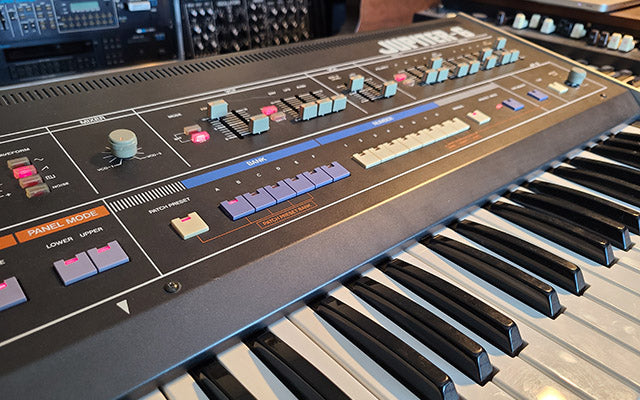Share
Cherry Audio Mercury-6 Synthesizer
Cherry Audio Mercury-6 Synthesizer
Couldn't load pickup availability

Sandwiched between the earlier Jupiter-4 and Jupiter-8 models in name only, the sophisticated Jupiter-6 has sometimes been considered a sleeper release. These days, it has persevered to become one of Roland's most notable and coveted classic synthesizers due to its distinctive dark and complex character. Mercury-6 captures all that is exceptional in this treasured polyphonic classic, boosts its extraordinary feature set for today's DAW production and workflow, and celebrates the ground-breaking innovation from the era that changed music forever.
If you've long yearned to explore the Jupiter-6, you'll love Mercury-6!
The Year Everything Changed
Released in 1983 as a more affordable alternative to the flagship eight-voice Jupiter-8, the six-voice Jupiter-6 nevertheless staked out an essential position in the history of analog polysynths. Though similar in appearance and feature set, the Jupiter-6 stood apart from the Jupiter-8 in its sound and capabilities. Unlike earlier Roland polysynths with lowpass filters plus a rudimentary non-resonant highpass filter, the Jupiter-6 featured a true multimode filter with 24 dB/oct lowpass, 24 dB/oct highpass, or 12 dB/oct bandpass modes. This versatile filter design lent a more aggressive sound than previous Jupiters, making the Jupiter-6 a natural for cutting-edge techno and electro styles.
Though something of a "hidden feature," the Jupiter-6 VCOs supported multiple simultaneous waveforms, and its two LFOs and oscillator cross mod capabilities provided extensive modulation possibilities. Its earthshaking solo and poly unison modes enabled massive lead and bass sounds, and it was notably one of the first synthesizers to include the then-new MIDI protocol.
Although often praised for its harmonic complexity and ability to cut through a mix, the cost-cutting in the Jupiter-6 design resulted in some disadvantages. Output was mono only and it was limited to six-voice polyphony. The Jupiter-6 had an impressive (for the time) split keyboard and patch preset storage functionality, but this six-voice maximum hampered its potential. And though it was considerably less expensive than the Jupiter-8, its timing was ill-fated when the digital revolution was ignited by the release of Yamaha's revolutionary DX-7 FM digital synth the same year.
Despite its noteworthy character, the Jupiter-6 is not one of those synths immediately identified with recognizable sounds from hit songs. Nevertheless, it was the Jupiter-6 behind the bass line of Ray Parker Jr.'s classic "Ghostbusters," and it found purchase in the work of Human League, Tangerine Dream, Thomas Dolby, Trans-X, Vangelis, and Devo. In a testament to its staying power over the decades, its popularity grew in genres such as big beat, house, and techno through The Chemical Brothers, Moby, and The Crystal Method. Electronic music duo Orbital has been a vocal proponent of the Jupiter-6 and, more recently, it has been a significant part of the sound of Daft Punk and Junkie XL.

Mercury-6: 40 Years in the Making
Cherry Audio's Mercury-6 brings the Jupiter-6 experience into the future and celebrates the invaluable contribution that MIDI itself has made to the music community over the past 40 years. Mercury-6 captures all that is exceptional in this classic and boosts the extraordinary feature set and functionality for today's DAW production and workflow. We've added velocity sensitivity, improved the split mode, and added a layer mode capable of stacking two different sounds simultaneously with per-layer stereo panning, detuning, and sustain. A panel control lets users easily select and navigate between these layers and includes a utility function for exchanging settings between the lower and upper layers, or even between presets. And with polyphony extended to 16 notes, Mercury-6 won't easily run out of voices.
We've reproduced the arpeggiator, including the hidden Down/Up mode of the original, and augmented it by adding a Random mode and MIDI tempo sync. A chord memory mode enables multiple notes to be stored and played back with a single key. We've improved the functionality of the LFOs with a retrigger for LFO-1 and an always-on option for LFO-2, both syncable to MIDI tempo.
We've also introduced an integrated studio-quality effects panel with brilliant-sounding distortion, phaser, flanger/chorus, delay, and reverb. With additional touches such as per-layer drift control, over 500 expertly designed presets, and flexible MIDI mapping, Mercury-6 will satisfy both vintage synth aficionados and today's music producer.
Mercury-6 Features
- Highly optimized, massive dual-layer voicing architecture with 16 polyphonic voices per layer. Keyboard split or stacked layer modes allow two simultaneously playable layers, with separate per-layer controls for all parameters, including effects
- Two VCOs per voice with combined waveform capabilities: triangle, ramp sawtooth, noise, and square or variable pulse
- Multimode filter with a 24 dB/oct lowpass, 24 dB/oct highpass, or 12 dB/oct bandpass modes
- Accurate reproduction of the original's advanced VCO-2 to VCO-1 FM cross-modulation for searing tones
- Precisely implemented portamento and glissando modes
- Exactingly replicated arpeggio section with MIDI tempo sync, the hidden Down/Up mode of the original, and the addition of a Random mode
- Powerful solo and polyphonic unison modes for fat, stacked sounds
- Two tempo-syncable LFOs with extended retrigger functionality
- Per-layer drift control for oscillators and filter frequencies for authentic analog character
- Single-key chord memory mode
- Over 500 presets, created by a talented team of sound design veterans, easily accessible in a convenient preset browser
- Panel Control for selecting layer controls, including extensive utility functions for duplicating and exchanging synthesis and effects parameters between layers and presets.
- Studio-quality integrated effects: distortion, 4/8/12 stage phaser, flanger/chorus, three types of delay with sync, and four types of reverb, with easy-to-access global or layer settings
- Complete MIDI control and DAW automation for all controls, with easy-to-use MIDI learn and mapping (Preset and Global)
- Cherry Audio's popular Focus zoom-in feature, as well as standard UI zoom and resize via drag
- Complete documentation available directly online from the instrument or in downloadable PDF format
- Highly optimized coding for optimal performance with ultra-low CPU load, and multithreaded processing for presets using Split and Layer modes
- User-adjustable oversampling control


